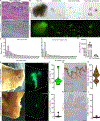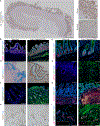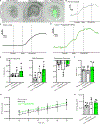Human pluripotent stem cell-derived organoids repair damaged bowel in vivo
- PMID: 39270642
- PMCID: PMC11824906
- DOI: 10.1016/j.stem.2024.08.009
Human pluripotent stem cell-derived organoids repair damaged bowel in vivo
Abstract
The fundamental goal of tissue engineering is to functionally restore or improve damaged tissues or organs. Here we address this in the small bowel using an in vivo xenograft preclinical acute damage model. We investigated the therapeutic capacity of human intestinal organoids (HIOs), which are generated from human pluripotent stem cells (hPSCs), to repair damaged small bowel. We hypothesized that the HIO's cellular complexity would allow it to sustain transmural engraftment. To test this, we developed a rodent injury model where, through luminal delivery, we demonstrated that fragmented HIOs engraft, proliferate, and persist throughout the bowel following repair. Not only was restitution of the mucosal layer observed, but significant incorporation was also observed in the muscularis and vascular endothelium. Further analysis characterized sustained cell type presence within the regenerated regions, retention of proximal regionalization, and the neo-epithelia's function. These findings demonstrate the therapeutic importance of mesenchyme for intestinal injury repair.
Keywords: cell therapy; enteroid; human intestinal organoid; intestine; tissue regeneration.
Copyright © 2024 Elsevier Inc. All rights reserved.
Conflict of interest statement
Declaration of interests CCHMC has a patent application in process related to the work in this study.
Figures




References
MeSH terms
Grants and funding
LinkOut - more resources
Full Text Sources

